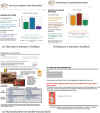Examining the longer-term efficacy of brief, alcohol-focused personalized feedback interventions for individuals with internalizing distress: Secondary analysis of a randomized controlled trial
- PMID: 40202024
- PMCID: PMC12215288
- DOI: 10.1111/add.70044
Examining the longer-term efficacy of brief, alcohol-focused personalized feedback interventions for individuals with internalizing distress: Secondary analysis of a randomized controlled trial
Abstract
Background and aims: Efficacy of brief alcohol interventions for young adults with internalizing distress (i.e. symptoms of depression, anxiety and stress) is unclear. We tested the moderating effect of internalizing distress on the efficacy of alcohol single- and multicomponent personalized feedback interventions (PFIs).
Design: Secondary data were analyzed from a randomized controlled trial (RCT) testing the efficacy of single and multicomponent PFIs, compared with an attention-only control condition.
Setting: Participants were sampled from two West Coast universities in the United States. All study protocols were completed online.
Participants: Participants (n = 1137) were college students (63% female; Mage = 20.1 years; 62.6% non-Hispanic white) who reported on internalizing distress at baseline. Some individuals reported clinically significant symptoms (depression: mild/moderate = 24.0%, severe/extremely severe = 10.5%; anxiety: mild/moderate = 19.6%, severe/extremely severe = 11.4%; and stress: mild/moderate = 37.5%, severe/extremely severe = 6.0%).
Interventions: There were four different alcohol single-component PFIs administered and an attention-only PFI control. Alcohol PFIs varied in their complexity and single-component PFIs (i.e. personalized normative feedback) were compared with multicomponent PFI (i.e. containing additional alcohol-focused psychoeducation).
Measurements: Baseline levels of internalizing distress were measured using the summed total of the Depression, Anxiety and Stress Scales (DASS). Drinking outcomes (alcohol consumption, peak eBAC, alcohol-related consequences) were measured at baseline, 3, 6 and 12 months post-intervention.
Findings: Alcohol PFI (compared with attention-only control) reduced alcohol consumption and related consequences at 6-month [rate ratio (RR)Consumption = 0.85, P = 0.004] or 12-month follow-ups (RRConsumption = 0.76, P < 0.001; RRConsequences = 0.85, P = 0.020), regardless of baseline DASS score. Participants with higher DASS scores (compared with those with lower DASS scores) reported lower 6-month alcohol consumption after receiving a single-component intervention (RR = 0.80, P < 0.001). However, individuals with higher DASS scores (compared to those with lower DASS scores) reported more 6-month alcohol-related consequences after receiving a multicomponent intervention (RR = 0.78, P = 0.004).
Conclusions: Personalized feedback interventions may demonstrate efficacy towards reducing drinking in young adults and appear similarly beneficial across levels of internalizing distress, although lower-complexity interventions may be more efficacious.
Keywords: alcohol; alcohol consumption; alcohol‐related consequences; internalizing distress; personalized feedback interventions; tailoring.
© 2025 The Author(s). Addiction published by John Wiley & Sons Ltd on behalf of Society for the Study of Addiction.
Conflict of interest statement
None.
Figures





Similar articles
-
Are online norms-based alcohol interventions efficacious for college students with higher social anxiety?Alcohol Clin Exp Res (Hoboken). 2025 Jul;49(7):1564-1575. doi: 10.1111/acer.70077. Epub 2025 Jun 2. Alcohol Clin Exp Res (Hoboken). 2025. PMID: 40457580 Clinical Trial.
-
Psychological therapies for post-traumatic stress disorder and comorbid substance use disorder.Cochrane Database Syst Rev. 2016 Apr 4;4(4):CD010204. doi: 10.1002/14651858.CD010204.pub2. Cochrane Database Syst Rev. 2016. PMID: 27040448 Free PMC article.
-
Psychological therapies for the treatment of mental disorders in low- and middle-income countries affected by humanitarian crises.Cochrane Database Syst Rev. 2018 Jul 5;7(7):CD011849. doi: 10.1002/14651858.CD011849.pub2. Cochrane Database Syst Rev. 2018. PMID: 29975811 Free PMC article.
-
Psychological interventions for coronary heart disease.Cochrane Database Syst Rev. 2017 Apr 28;4(4):CD002902. doi: 10.1002/14651858.CD002902.pub4. Cochrane Database Syst Rev. 2017. PMID: 28452408 Free PMC article.
-
Psychological therapies for treatment-resistant depression in adults.Cochrane Database Syst Rev. 2018 May 14;5(5):CD010558. doi: 10.1002/14651858.CD010558.pub2. Cochrane Database Syst Rev. 2018. PMID: 29761488 Free PMC article.
References
-
- Lovibond SH, Lovibond PF. Manual for the depression anxiety stress scales [internet] 2nd ed. Sydney, Australia: Psychology Foundation; 1995. [cited 2024 Oct 28]. Available from: https://doi.apa.org/doi/10.1037/t01004-000 - DOI
Publication types
MeSH terms
Grants and funding
- R01AA012547/AA/NIAAA NIH HHS/United States
- K99 AA029459/AA/NIAAA NIH HHS/United States
- T32AA07455/AA/NIAAA NIH HHS/United States
- F32 AA029865/AA/NIAAA NIH HHS/United States
- K23 AA031034/AA/NIAAA NIH HHS/United States
- K23AA031034/AA/NIAAA NIH HHS/United States
- F32AA029865/AA/NIAAA NIH HHS/United States
- K99029459/AA/NIAAA NIH HHS/United States
- R00029459/AA/NIAAA NIH HHS/United States
- R00 AA029459/AA/NIAAA NIH HHS/United States
- R01 AA012547/AA/NIAAA NIH HHS/United States
- T32 AA007455/AA/NIAAA NIH HHS/United States
- F31 DA057796/DA/NIDA NIH HHS/United States
- F31DA057796/DA/NIDA NIH HHS/United States
- R37 AA012547/AA/NIAAA NIH HHS/United States
- R37AA012547/AA/NIAAA NIH HHS/United States
LinkOut - more resources
Full Text Sources
Medical

